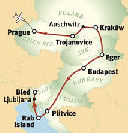I got up and was out of bed before 6:00. I soon discovered that I was in even worse shape than I thought. I had to lift my legs up quite a bit to do my crunches. I had unexpected trouble doing them on the tiled floor. That should have told me something. Nevertheless, I was out in the Planty by 6:15. It seemed unusually muggy; I seemed to have a little trouble breathing. At any rate, I only managed one lousy lap of the Planty.
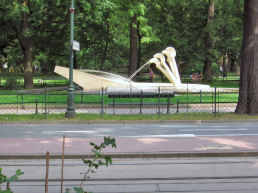
A fountain in the Planty.
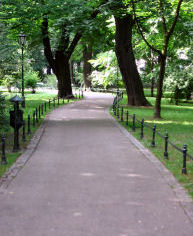
A paved path in the Planty.
Not many people were out in the park. I saw two couples sucking face (before seven in the morning!) and quite a few smokers, bikers, and people walking dogs. Dogs are the bane of joggers, but none of these canines seemed to have developed a taste for human ankles.
When I returned to the hotel, I took a shower. I got Sue up, and we went to breakfast. The layout was substantially the same, but this time the peaches were missing. Sue tried the roll that looked like a pig in a blanket. It was actually filled with Nutella, a nut-based spread that tastes a little like not very sweet chocolate. I liked it. As usual I pigged out on breakfast. My avowed intention was to skip lunch or dinner.
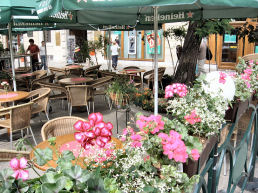
Here is where we waited for service for nearly thirty minutes on Friday evening.
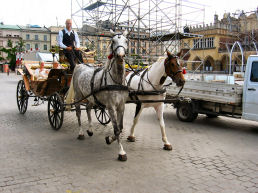
I took dozens of photos of horses; this was my favorite.
We learned that a few of the women had broken out in some sort of blotchy rash on their lower legs. Angela seemed to have the worst case. No one seemed to know what it was.
After breakfast I signed on to the Internet. I sent my dad some columns. I meant to reply to his e-mail, but I never found time to do it.
The Museum Czartoryski somehow had obtained both a Da Vinci oil painting and a Rembrandt. I am not a great art lover, but I was not going to be this close to a Da Vinci and miss the opportunity to see it. Tom, Sue, and I walked to the Museum Czartoryski, which was exactly one block past the Farina Restaurant in which we dined the first night. Our plan was to meet Patti at 11:30 at St. Mary’s Church to watch the opening of the altarpiece. 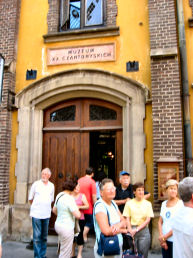
The entrance to the Museum Czartoryski.
I wanted to get to the Da Vinci as quickly as possible before the place got too crowded. We went up the stairs past the armory exhibit. Tom, who is even less interested in art than I am, split off on his own. Sue and I kept climbing to the art exhibit. As we sat in the first room of paintings, Lyle, Andy, and Pam joined us. A huge crowd of kids was nearby. They made me nervous.
The two big attractions at the museum were its stunning oil by Leonardo da Vinci, "Woman with Ermine" and a painting by Rembrandt about the Good Samaritan. I could hardly take my eyes off of the former. I know very little about art, but Da Vinci’s paintings have always seemed magical to me. This one is so weird (who pets an ermine?) and yet realistic that I did not know what to make of it. The woman’s face vied for our attention with her elongated hands. It somehow seemed natural for her to be clutching that weasel. The fact that the painting was behind glass was not particularly bothersome.
The Rembrandt had much less effect on me, and the glass that covered it was much more of a problem. The figures in the painting were so tiny that their actions were dwarfed by the stunning chiaroscuro of the landscape. This was a rendition of a parable in the bible. Why would Rembrandt make the people seem so unimportant? I was also somewhat put off by his inclusion of windmills in a depiction of a story set in the Holy Land. I just did not get this at all.
Sue decided that she wanted to join up with Tom. She told me that she would meet me in the weaponry exhibit or the card shop.
I enjoyed looking at many of the other paintings. One room was devoted to portraits. I did not expect to recognize anyone represented there, but I was very surprised to come on one depicting Pope Clement VII as a young man named Julian de' Medici. There was also a portrait of Charles V, the most powerful of all the Hapsburg emperors, and one that might have been Don John of Austria, the leader of the Christian navy at the famous battle of Lepanto.
A picture of the crucifixion amused me. A man with a lance, presumably Longinus, was wearing a brightly colored tunic with bold diagonal stripes. He looked absolutely nothing like a Roman soldier. There was a weird painting entitled "Still Life with Lobster," which was hung on the wall next to several oils devoted to carcasses of game animals.
There were two depictions of the death of Mary. In both of them there were full-sized renderings of people of the era behind tiny figures of knights and other anachronistic people. I am not sure what that was supposed to convey. Wait a minute. According to the Church Mary never died; she was assumed into heaven. I had to assume that prior to the time of Pope Pius XII, it was not considered sinful to have such heretical thoughts about Mary’s demise.
At about 11:00 I started looking for Tom and Sue. I had to retrace my steps through the museum to get to the weaponry exhibit. As I reached the room with the Leonardo, I spotted Kasia explaining the painting to an elderly couple. She was obviously working, so I did not bother her. There were only two of them and twenty-six of us. I wondered if they paid thirteen times as much per person per hour for her time.
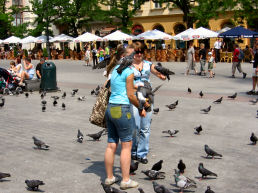
Pigeon-feeding in the square.
I found neither Sue nor Tom. I made my way back to the window near the entrance where they sold tickets. I went inside the nearby card shop, but I did not see either Sue or Tom. I waited for them for a few minutes in the area near the door. The Millers came in. Paul asked me if the museum was worth it. I told him that I certainly thought that it was a worthwhile experience. After all it only cost nine złoty. At 11:15 I thought that I had better leave. I did not intend to miss the showing of the altarpiece by a minute or two two days in a row. The only firm appointment that I could remember us setting was with Patti at 11:30. I found her quite quickly in a gift shop near the entrance to the church. She said that the church was not open yet. I entered a little store located next to the church to look for a pair of scissors. For a moment I thought that I might be in luck. They had pens and photo albums and paper, but I did not see anything resembling scissors.
As soon as they opened the church doors at about 11:40 I rushed over to make sure that we did not get aced out again. Lots of people already had tickets; there must have been an easier way to do this. As I elbowed my way to the counter, Patti came over to join me, and shortly thereafter Tom and Sue appeared. I bought four entrance tickets. The four of us went inside and took seats in pews on the left. Patti and Sue also bought camera passes inside the church from the man running the photography inquisition.
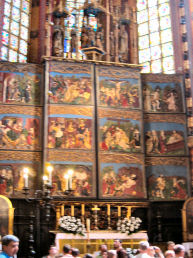
The altarpiece before it was opened.
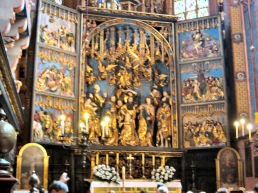
What all the fuss was about.
We tried to offer our seats to Nedra and Barbara, whom we saw standing behind the pews. We were unable to get their attention. Sue took a lot of movies and a couple of photos for me. She is responsible for the before and after photos shown on this page, so don't blame me for their fuzziness. A diminutive nun in a brown habit walked up to the altar area and gave a soft little speech in Polish. Then she produced a very long pole with a hook on the end, and used it to pull open the center parts of the covering of the altarpiece. This revealed the center section of the triptych, which depicted the last day of Mary at the bottom and above that her ascension into heaven. On the sides were new panels about the annunciation, nativity, and epiphany on the left and the resurrection, ascension, and Pentecost on the right. The unpleasant stuff in between would be forgotten until 6 p.m.
We walked through the rest of the church, which was also extremely ornate. After that Tom and I decide to go up into the bell tower, but it was closed for a break. It was a good thing, too. A moment after we would have entered the tower the bells would have tolled twelve o'clock. We would have been deafened. Out in the square we listened to the trumpeter. I chased him all the way around the tower, but I never laid eyes on him. I figured that I would only have two more shots at him, since we were scheduled to leave for the salt mine at three.
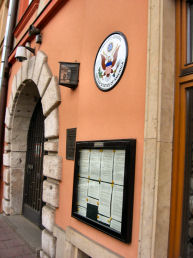
The American Consulate.
Outside of the church three or four guys in outrageous outfits just stood there waiting for people to pay them to pose for a photo with some kids. One of the guys was wearing plate mail. The temperature was approaching eighty degrees in the shade. He must have been miserable. We were not scheduled to link up with the ladies for almost an hour, so we spent most of the time wandering the streets outside of the square. We found some very unusual places, but we did not go into any of them. We found the American consulate, and I managed to take a photo of it without getting arrested.
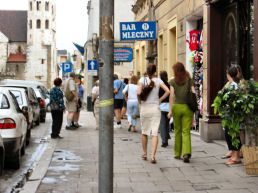
Tom, Lauren, Barbara, and Nedra outside of Bar Mleczny.
Patti wanted to go to a milk bar for lunch. She was finally in Poland, and she wanted to eat the way that the Poles ate. Tom led us down to Bar Mleczny on the street on which we had had supper the previous evening. I was adventurous enough to go a few feet into the place. That was enough exposure for me to determine that it was not for me. It was hot, crowded, and confusing. Maybe the food was cheap and tasty, but I was not really that hungry anyway. I could not imagine Sue staying for long in a place that was that stuffy, and I was right. She came out a minute or two later. The Corcorans were not far behind her. 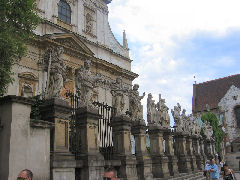
We were looking for kielbasa and beer, but all we found were saints.
Steve and Janet came by. They told us that they had had beer and kielbasa at a place just around the corner. That sounded good to all of us. We went down the street to try to find it, but we must have gone in the wrong direction. We never saw it. Patti and Tom decided to brave the milk bar after all. 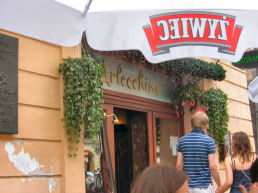
Our second Italian restaurant in Kraków.
Sue and I ate at a table on the sidewalk at a restaurant named Arlecchino. The table had an umbrella that would shelter Sue from the sun. I was surprised and delighted to see that the menu was in Italian! Well, Italian and Polish and English. We had fun with the waitress, who knew just enough Italian and English to deal with us. Sue ordered risotto with asparagus. I had the traditional Polish dish of penne al pesto. I had a beer. I did not note what Sue ordered, but it had a lime and some mint in it. She said that the asparagus was good, but the risotto was, well, risotto, which is not my favorite. I have never understood why anyone would make a pasty mess out of perfectly good rice. My pesto was tolerably good, but the sunflower seeds did not do a great job of standing in for the pignoli nuts.
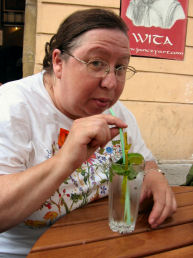 Sue and her cool drink. | 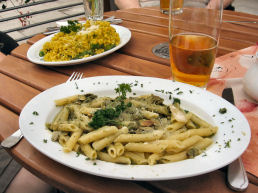 Pesto and rissoto. | 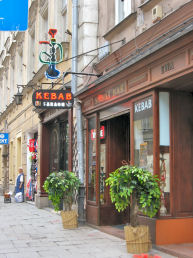 We decided not to stop in for a toke at the hookah bar. |
Tom and Patti joined us for a drink at the end of the meal. Tom told us that we had chosen wisely in avoiding the milk bar. Patti had eaten boiled pierogis at Bar Mleczny. She said that they were pretty good, but they did not sound very appetizing to me.
We assembled at the hotel at 3:00 for our day trip to the Wieliczka salt mine. We climbed aboard Bojan’s bus. On the way I noticed a fairly large department store named Jubelat. It seemed to be only a few blocks from the hotel. I figured that Jubelat might be a good place to buy some scissors. I resolved to go there on our return from the mine.
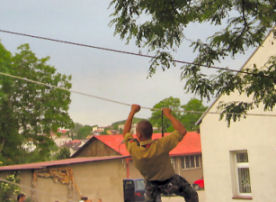 The wire-walker. | 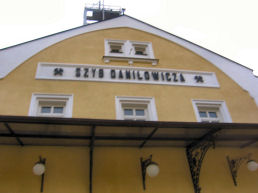 The mine. | 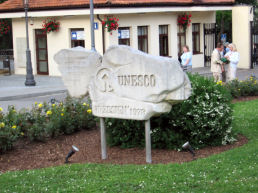 The UN liked it, too. |
As we drove through suburban Kraków, I was surprised to see some uniformed guys practicing walking on wires.
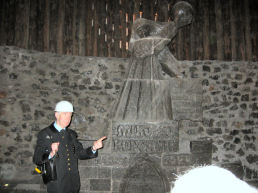
George and a salt statue.
The mine was actually quite modern, at least on the outside. Our guide for the tour was named George. His vocal patterns and even his mannerisms reminded both Sue and me of Boris Karloff. Before we began the long descent into the mine he told us that the mine had operated from the thirteenth century through 1997. Copernicus toured the mine in 1493.
The descent into the mine was on foot. We went down three or four hundred steps. It could not have been more boring. It was rather easy to keep track of the number of steps. All of the landings were numbered, and each flight contained the same or almost the same number of steps.
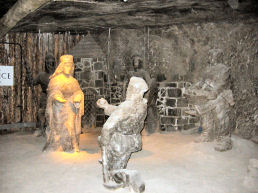
No, Queen Kinga was not married to King Queena.
The tour itself started at the bottom of the staircase. We wandered through the tunnels of the mine. Mostly we looked at dioramas portraying the history of the mine interspersed. There was also some actual machinery. Interspersed were chapels and other artwork made out of salt. The problem with this type of tour is that there just did not seem to be that much to learn about salt.
The first diorama related a somewhat questionable tale of Queen Kinga. As part of her betrothal to a Polish prince she promised to bring salt to the people of Poland as her gift from her native Hungary. For some reason she threw her ring down a mine shaft in Hungary. After they started mining at Wieliczka, they supposedly found her ring in a cake of salt. George said that she has been beatified. So, even though they have several chapels to her and call her St. Kinga, she is not an official Catholic saint. [Wrong. She was canonized by Pope John Paul II in 1999.]
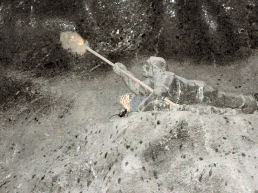 A guy with a torch. | 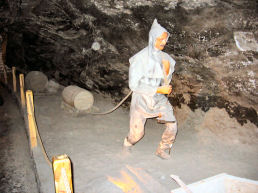 Man-hauling with wooden sledges. | 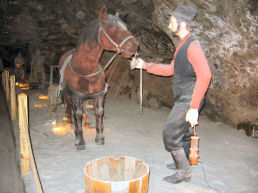 Horse-drawn carts. |
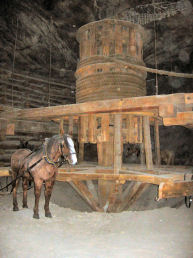 The huge horse-powered wheel. | 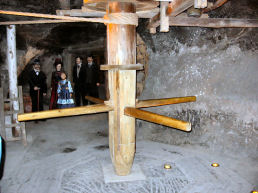 We got to try this one out ourselves. | 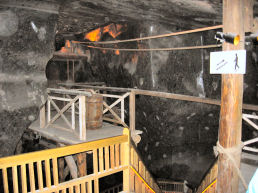 Pulleys helped with the hauling. |
The next set of dioramas showed fourteenth century wooden sledges and fifteenth century carts. Iron was not introduced until the nineteenth century. We saw separate elaborate machines for lifting kegs of salt. Four pairs of horses turned a gigantic wheel for one of them. Another was powered by four humans. Counterweights made it very easy to push.
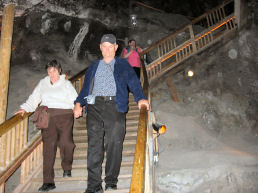 I was pretty sure that this was not a highlight for Pam, ... | 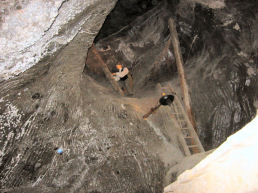 ... but it could have been worse. | 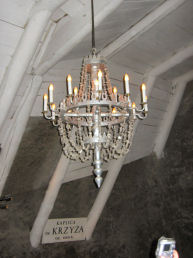 A salt chandelier. |
We spent a good bit of time in the chapel called Kaplica Kinga. It is fifty-four meters by nineteen meters by twelve meters high. George said that the donkey in one bas relief was walking incorrectly. If it walked like that, it would fall over. There was also a statue of Pope John Paul II, who actually took this tour. I wonder if he might have beatified Kinga. I know that he was responsible for over four thousand beatifications.
[Wrong. She was beatified back in 1690 by Pope Alexander VIII, the pontiff who loosened things up after Innocent XI.]
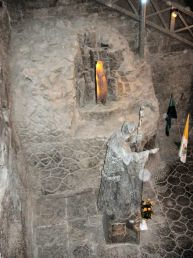 Pope John Paul II visited this mine in 1930. | 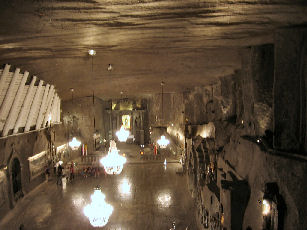 Kaplica Kinga. | 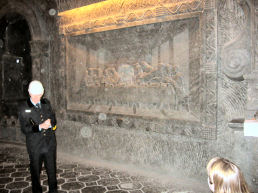 A bas relief of the Last Supper. |
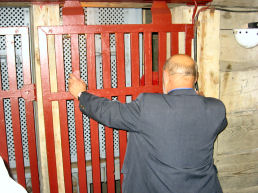
The elevator.
At the end of the tour we had to walk through a snack bar and a gift shop at the end of which were benches with tables in front of them. Tom and I took a seat next to the Millers. I guess that the four of us with the table in front of us looked like a group of officials. Other members of the tour kept coming up to us and told us that they wanted to register. I tore out four pieces of paper from my notebook, labeled them A-E, F-L, M-R, and S-Z. I put one in front of each of us. This was a big hit.
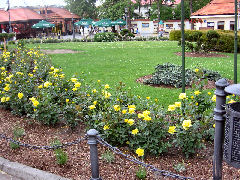
The outside of the mine was much more colorful than the inside.
The salt mine was better than this write-up might lead one to believe. It was certainly worth the devotion of a few hours. There was not much to learn about the technology of salt, but the statues were quite impressive.
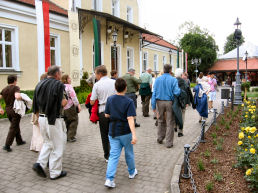
“Do widzenia” to the mine.
We came back to the surface by elevator. They packed eight of us into each car. Even though the tour ended approximately 130 meters (about forty stories) beneath the surface, the ride to the top only took a few seconds. Getting out of the elevator was much more difficult than entering it; our largest person, Rawlins McKinney, was standing in front of the door, which opened inward.
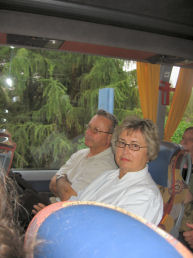 The Cresaps back on the bus. This photo obviously preceded the opening of the Becherovka. | 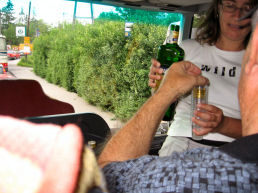 Susana and the Becherovka. | 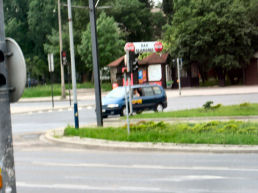 Red-neck outpost in Kraków. |
On the bus Susana broke out a lot of little plastic shot glasses and her bottle of Becherovka, a Czech brandy that was flavored with a mysterious selection of herbs. Take it easy with this stuff.
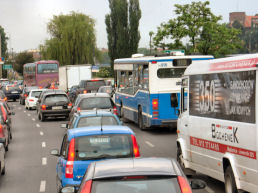
Maneuvering that big bus through this could not have been fun.
On the drive back to the hotel we spotted the Bar Alabama, which was pretty close to the hotel. We all called to Rawlins so that he could get a photo of it. He remarked that rednecks had preceded him to Kraków. I took a couple of snaps myself.
When we arrived back at the hotel, I decided to walk to Jubelat to try to purchase a pair of scissors. I was not sure exactly where it was, but I knew that it was near the river, and on our side. I was pretty sure that I could locate it.
As I approached the Sheraton Hotel, I could see Jubelat about a block past it. However, the police had blockaded the street for both vehicle and pedestrian traffic. My choices were to wait where I was or to take a detour around the back of the hotel. I chose the latter even though it added ten or fifteen minutes to my journey. [I later learned that this was probably the Chinese delegation leaving town.]
Jubelat was open, but when I entered, I did not know which way to go to find the department that might sell scissors. I went inside, but there was nothing but groceries. A security guard eyed me suspiciously. I just had to hope that I looked lost to him rather than evil. I went back outside and discovered that the rest of the store had closed at 4 p.m. because it was Saturday. I guess that no one in Poland buys anything but groceries on Saturday evening.
I was frustrated because I never like to leave loose ends. I walked all the way back up to the main square to see if any likely retail stores in that area were open. The Galeria Centro store was open, but it looked intimidating to me, so I did not go in. I did, however, notice that the square was not nearly as crowded as it had been Friday evening.
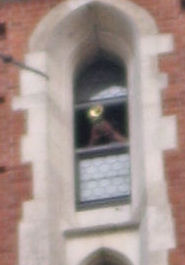
The trumpeter in the tower.
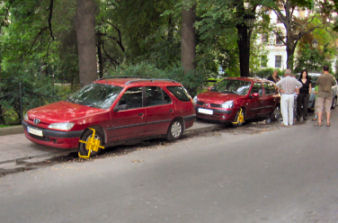
They were serious about parking violations.
At 7 p.m. I finally got some pretty good shots of the trumpeter and the tower.
[This convinced me that I needed a camera witha more powerful lens.]I walked back to the hotel to talk to Sue about how we might spend the evening. As I passed through the Planty, I noticed that a cop was writing tickets. The cars that were parked on the road that went through the Planty were sporting brand new Denver boots.
Sue and I decided to spend our last evening in Kraków at one of the cafes by the square. On our way to the square we encountered Patti and Tom dining at the restaurant across the parking lot from the hotel. We told them that we did not know what we were having for supper or where, but we intended to spend our remaining 85 złoty.
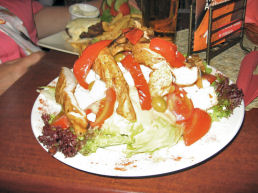
All I had for supper was this salad.
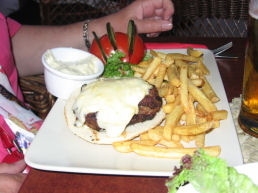
Sue’s cheeseburger, or cheeseburg as we say in New England.
We ate at a place called TriBeCa. It was either American or (more likely) pseudo-American. Sue ordered nachos and a cheeseburger with fries. I had a gigantic chicken salad. It was more than we could eat, and it used up only 64 of our 86
złoty. The food was not too good, and the beer was not too good, but at least I got to see the female cops in mini-skirts come into the square and start blowing their whistles and spritzing their perfume. It was not a bad way to spend our last Polish evening. We got a little better feeling for the night life of Kraków.
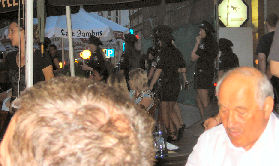
“I’m probably guilty of something; you ladies had better take me in.”
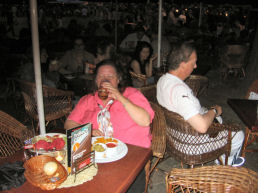
Sue and the faux Llewellyn.
Sue made me take a picture of one of the guys at the next table. She said that he reminded her of her dancing buddy, Llewellyn.
Afterward we went back to the hotel room. I washed a few things and packed up the rest. I downloaded photos and worked on the journal until my mind could no longer function. I tried to dream about getting arrested in Kraków, but it did not work.
